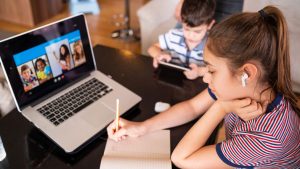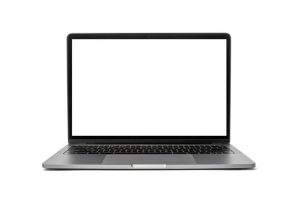Rising Above the Pandemic to Make the Rest of the School Year Great for the Students We Teach
12/29/2020

Winter break is finally here and I'm exhausted. My colleagues are worn out. My administrators are ready for a rest. We're pooped. But we feel a sense of satisfaction that in a year that will go on record as the ultimate crapfest, we've done our best to make it as great as we possibly can for every one of our students. I know the same is true in districts across the country.
It has been a very long bunch of months since Covid-19 began impacting our lives. The way we eat, drink, socialize, hospitalize, plan, travel, grocery shop, and especially the way we work. Teachers know this just as well as anyone. Everyone muddled through the first go-round of online classes. Using tools like web-based document exchange and chat platforms of all kinds, teachers figured out ways to creatively communicate with students in groups or individually… and when there wasn't an internet connection that allowed us to do it remotely, we could be relied on for socially distanced home visits, drive-up assignment drop-offs, phone calls, and even snail mail deliveries to keep school running.
"We're Not Sure How You Do It Every Day!"

For a brief moment in time, teachers were publicly heralded and effusively thanked for the hard work…which we've done even before Covid-19. Because parents and child care-givers had to assume the responsibility for doing that which we have always done, the burden began to take a toll on folks who weren't or aren't certified teachers but those souls kept on working to do what was best for their kids.
We were given praise on social media, news casts, and in conversations shouted across and around neighborhoods as adults stepped outside their homes during quarantine. Always a topic of conversation, parents and caregivers would proclaim they had no idea how teachers "do it" all day long.
It was even being said that teachers just don't make enough money. Well, duh.
Our profession was finally getting the recognition it so rightfully deserves.
We are awesome!
We worked VERY hard throughout it all and finally, our efforts were being recognized. It just plain old felt good, didn't it? I mean, how often in the past 20 years have we, as a profession, been able to say that we were being honored by pretty much EVERYONE?
As beach chairs, body boards, and coolers were being put away, the end of summer vacation came. The beginning of a new, and extraordinarily different approach to educating our nation's children had to be presented.
Parents and caregivers had spent the better part of five months with their students and were ready to hand their children back to us. Never mind that the nation was still in the midst of a pandemic, the likes of which none of us has ever known. It was August and time for school to resume. Many wanted or needed to get their kids back into class.
Districts across the U.S. have re-opened schools using a face-to-face, hybrid, or strictly virtual approach for the 2020-2021 school year. Teachers and leaders across the country have worked together to create a plan which has proven to be rigorous while still being accessible to all students.
Challenges of Online Learning

Accessibility. Districts have been working hard to distribute devices to students who don't have them and while that is a laudable effort, what remains is limited access to internet service. Districts are cleverly equipping buses with WiFi hubs as they roll into neighborhoods to deliver much needed meals to students. For those who do not have access to computers, many schools are offering appointments for students to visit their neighborhood schools to access any necessary technology and submit assignments. For those schools who are face-to-face, distancing remains a requirement in the classrooms, bathrooms, cafeterias, and other common areas. Masks are required. Hand-washing is encouraged. Apart from a reduction in the number of fellow students on site, it is school as normal as it is going to be for these kids.
Preparation of materials. The importance of having prepared packets of work-not packets full of worksheets-is critical for those who are unable to access classrooms online or who, like my class of students, have varying developmental needs which are not well-suited to online learning. They are equally entitled to an education just like their general education peers. While my colleagues are spending a lot of time online hosting live classes, I'm spending a lot of time gathering specifically curated individually relevant lessons for my students with special needs. Individual Education Programs drive the course and trajectory for all special education students. General education teachers typically plan one lesson per content area per day. Special education teachers plan multiple lessons per content area per day. It's a definite balancing act! While we have some at-home/online learning platforms purchased by our districts, any special education teacher will tell you that students with significant disabilities do not fit into the same virtual learning mold as do their general education peers. Some do well, some do not. Some of my parents have opted to keep their kids at home. They do not wish to subject their children to any health risk and so I teach during the day and then I provide a virtual course session after hours then drop off materials to coincide. This model has leaned heavily on parental/caregiver support.
Security is as important as ever. Teachers are spending time learning the ins and outs of the platforms they are using as well as spending time learning to set security controls and locking down virtual classrooms from being entered by those who are ill-intentioned. Several friends have learned, the hard way, that Zoom chats need to be secured with each and every use.
Unauthorized data collection. The Federal Bureau of Investigation has warned that personal, medical, and academic data of students, protected under the Family Educational Rights and Privacy Act, is at high risk of being breached. One company, whose platform is used for virtual education by students in Kindergarten through college, offers vehement assurances that data is not being sold. However, there is no guarantee that data will not be shared with third parties, such as retailers of various types, to track everything from interests to behavioral patterns to tracking of health issues.
Attentiveness of students. Teachers have had to kick it up in a big way, especially teachers of the K-4 set. A friend of mine is a music teacher. He has found so many fun ways to engage kids in lessons. While their parents may not appreciate the wooden spoon and pot-banging, his kids are on track to meet the curricular goals and objectives set by his state. Additionally, many specialist area teachers are hosting virtual winter concerts and art shows. YouTube has enough to warm even the Grinch-iest of hearts. Physical Education teachers have found a blend of on-site activities to maintain social distancing guidelines while simultaneously providing videos online to keep the movement going while at home.
Behavioral issues: my friend Donna teaches seventh and eighth grade Social Studies in a blue collar community. Her district is all virtual. In previous years, the behavior issues were typical of the age group. There was social drama, forgotten homework, and private conversations between students while Donna was delivering a lesson. "A lot of those things remain the same. The only difference is, I have learned to simply shut off the chat box. Problem solved. If they want to chat, they can do it before or after class time, but not during." Her sister Lisa teaches in Pittsburgh. "One of my 8th grade girls logged in for Math class, sat down, and was accounted for in as I took attendance. Then she got up, left the class, and returned within five minutes of the end of the period. When I asked her what had happened, she said she needed to make a sandwich, eat lunch, then go grab a quick shower because she had plans with her friends right after class." Lisa shared that the student still had two remaining class periods and to the best of her knowledge, going to their local nail salon wasn't part of the next two teachers' lesson plans.
Stay one step ahead: students fare best when they are well informed of classroom expectations in the virtual, blended, and the face-to-face setting. When you head back after break, give students a refresher of classroom etiquette and other expectations. Maintain office hours. Have a basic dress code for yourself as well as for students, just like if you were all on campus. Keep your presentations full of as much action and content as possible. Break out into small groups for conversation-driven activity among the groups but be sure to check in on their progress. Let them know you'll be jumping around to each group randomly-just like you would in-person. As Harry Wong notes, the key to a successful day in the classroom is a teacher providing a well-planned day.
Revel In the Respite

When we started the current school year, the majority of us were unsure how it was going to unfold. The one thing our profession agreed to provide itself was the gift of grace. While the data about instructional impact won't be fully known for a few more months, it won't be for lack of effort and hard work on the part of educators across the country.
Enjoy this time of rest and rejuvenation. Embrace the chance to restore your soul. Give your brain an opportunity to stop running on all cylinders as you "zoom" to the relaxation you so richly deserve.
- Dear Novice Teacher:An Open Letter About What You Really Need To Know For a Successful Teaching Career - November 9, 2021
- I Never Forgot What It Felt Like to Struggle in School… So I Decided to Become the Teacher I Always Wished I Had - October 8, 2021
- The Issue of Bullying Students with Disabilities Hits Particularly Close to Home for Me - August 16, 2021









